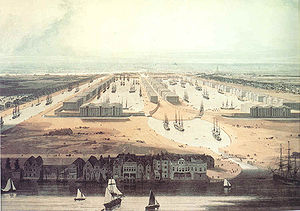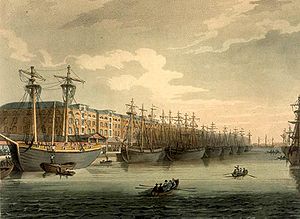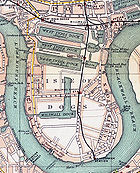
West India Docks
Encyclopedia


Dock (maritime)
A dock is a human-made structure or group of structures involved in the handling of boats or ships, usually on or close to a shore.However, the exact meaning varies among different variants of the English language...
s on the Isle of Dogs
Isle of Dogs
The Isle of Dogs is a former island in the East End of London that is bounded on three sides by one of the largest meanders in the River Thames.-Etymology:...
in London
London
London is the capital city of :England and the :United Kingdom, the largest metropolitan area in the United Kingdom, and the largest urban zone in the European Union by most measures. Located on the River Thames, London has been a major settlement for two millennia, its history going back to its...
, the first of which opened in 1802. The docks closed to commercial traffic in 1980 and the Canary Wharf
Canary Wharf
Canary Wharf is a major business district located in London, United Kingdom. It is one of London's two main financial centres, alongside the traditional City of London, and contains many of the UK's tallest buildings, including the second-tallest , One Canada Square...
development was built on the site.
History
Robert MilliganRobert Milligan
Robert Milligan was a prominent English merchant and ship-owner, and was the driving force behind the construction of the West India Docks in London....
(c. 1746-1809) was largely responsible for the construction of the West India Docks. Milligan was a wealthy West Indies merchant and shipowner, who returned to London having previously managed his family's Jamaica
Jamaica
Jamaica is an island nation of the Greater Antilles, in length, up to in width and 10,990 square kilometres in area. It is situated in the Caribbean Sea, about south of Cuba, and west of Hispaniola, the island harbouring the nation-states Haiti and the Dominican Republic...
sugar plantations. Outraged at losses due to theft and delay at London's riverside wharves, Milligan headed a group of powerful businessmen, including the chairman of the West India Merchants of London, George Hibbert
George Hibbert
George Hibbert was an eminent English merchant, politician, slave- and ship-owner, amateur botanist and book collector. With Robert Milligan, he was also one of the principals of the West India Dock Company which instigated the construction of the West India Docks on London's Isle of Dogs in 1800...
, who promoted the creation of a wet dock circled by a high wall. The group planned and built West India Docks, lobbying Parliament to allow the creation of a West India Dock Company. Milligan served as both Deputy Chairman and Chairman of the West India Dock Company. The Docks were authorised by the West India Dock Act 1799 - the first parliamentary (as opposed to a municipal) Act for dock building.
The Docks were constructed in two phases. The two northern-most docks were constructed between 1800 and 1802 (officially opened on 27 August 1802) for the West India Dock Company to a design by leading civil engineer
Civil engineer
A civil engineer is a person who practices civil engineering; the application of planning, designing, constructing, maintaining, and operating infrastructures while protecting the public and environmental health, as well as improving existing infrastructures that have been neglected.Originally, a...
William Jessop
William Jessop
William Jessop was an English civil engineer, best known for his work on canals, harbours and early railways in the late 18th and early 19th centuries.-Early life:...
(John Rennie was a consultant, and Thomas Morris
Thomas Morris, Civil Engineer
Thomas Morris, was and architect and Engineer.In 1784 he supervised the building of a dock at Glasson, on the River Lune.In 1789 he became Engineer to Mersey Docks and Harbour Board, whilst at Liverpool he was consulted regarding more docks at Glasson and completed Queens Dock.He left Liverpool in...
, Liverpool
Liverpool
Liverpool is a city and metropolitan borough of Merseyside, England, along the eastern side of the Mersey Estuary. It was founded as a borough in 1207 and was granted city status in 1880...
's third dock engineer, was also involved), and were the first commercial wet docks in London. British Prime Minister
Prime minister
A prime minister is the most senior minister of cabinet in the executive branch of government in a parliamentary system. In many systems, the prime minister selects and may dismiss other members of the cabinet, and allocates posts to members within the government. In most systems, the prime...
William Pitt the Younger
William Pitt the Younger
William Pitt the Younger was a British politician of the late 18th and early 19th centuries. He became the youngest Prime Minister in 1783 at the age of 24 . He left office in 1801, but was Prime Minister again from 1804 until his death in 1806...
and Lord Chancellor
Lord Chancellor
The Lord High Chancellor of Great Britain, or Lord Chancellor, is a senior and important functionary in the government of the United Kingdom. He is the second highest ranking of the Great Officers of State, ranking only after the Lord High Steward. The Lord Chancellor is appointed by the Sovereign...
Lord Loughborough
Alexander Wedderburn, 1st Earl of Rosslyn
Alexander Wedderburn, 1st Earl of Rosslyn was Lord Chancellor of Great Britain from 1793 to 1801.-Life:He was the eldest son of Peter Wedderburn , and was born in East Lothian....
were assisted in the foundation stone ceremony on 12 July 1800 by Milligan and Hibbert. The docks were formally opened on 27th August 1802 when the newly built and unladen Henry Addington was hauled in by ropes. It was followed by Echo, a ship laden with her cargo from the West Indies. For the following 21 years all vessels in the West India trade using the Port of London were compelled to use the West India docks by a clause in the Act of Parliament that enabled their construction.
The southern-most dock, the South West India Dock, later known as South Dock, was constructed in the 1860s, replacing an unprofitable canal
Canal
Canals are man-made channels for water. There are two types of canal:#Waterways: navigable transportation canals used for carrying ships and boats shipping goods and conveying people, further subdivided into two kinds:...
, the City Canal
City Canal
The City Canal was a short, and short-lived, canal excavated across the Isle of Dogs in east London, linking two reaches of the River Thames. Today, it has been almost completely reconstructed to form the South Dock of the West India Docks.-History:...
, built in 1805 by the City of London Corporation and acquired by the Company in 1829. In 1909 the West India Docks were taken over by the Port of London Authority
Port of London Authority
The Port of London Authority is a self-funding public trust established in 1908 by the Port of London Act to govern the Port of London. Its responsibility extends over the Tideway of the River Thames and the authority is responsible for the public right of navigation and for conservancy of the...
(PLA), along with the other enclosed docks from St Katharines
St Katharine Docks
St Katharine Docks, in the London Borough of Tower Hamlets, were one of the commercial docks serving London, on the north side of the river Thames just east of the Tower of London and Tower Bridge...
to Tilbury
Port of Tilbury
The Port of Tilbury is located on the River Thames at Tilbury in Essex, England. It is the principal port for London; as well as being the main United Kingdom port for handling the importation of paper. There are extensive facilities for containers, grain, and other bulk cargoes. There are also...
.
Layout

Limehouse Basin
The Limehouse Basin in Limehouse, in the London Borough of Tower Hamlets provides a navigable link between the Regent's Canal and the River Thames, through the Limehouse Basin Lock. A basin in the north of Mile End, near Victoria Park connects with the Hertford Union Canal leading to the River Lee...
. To avoid congestion, ships entered from the (eastern) Blackwall
Blackwall, London
Blackwall is an area of the East End of London, situated in the London Borough of Tower Hamlets on the north bank of the River Thames.The district around Blackwall Stairs was known as Blackwall by at least the 14th century. This presumably derives from the colour of the river wall, constructed in...
end; lighter
Lighter (barge)
A lighter is a type of flat-bottomed barge used to transfer goods and passengers to and from moored ships. Lighters were traditionally unpowered and were moved and steered using long oars called "sweeps," with their motive power provided by water currents...
s entered from the Limehouse
Limehouse
Limehouse is a place in the London Borough of Tower Hamlets. It is on the northern bank of the River Thames opposite Rotherhithe and between Ratcliff to the west and Millwall to the east....
end to the west. A dry dock for ship repairs was constructed connecting to Blackwall Basin. Subsequently the North London Railway
North London Railway
The North London Railway was a railway company that opened lines connecting the north of London to the East and West India Docks. The main east to west route is now part the North London Line. Other lines operated by the company fell into disuse, but were later revived as part of the Docklands...
's Poplar Dock
Poplar Dock
Poplar Dock is a small dock in east London. It connects to the Blackwall Basin of the West India Docks and, although independent of this system, has never had a direct connection to the Thames....
was also connected to Blackwall Basin.
The Docks' design allowed a ship arriving from the West Indies to unload in the northern dock, sail round to the southern dock and load up with export cargo in a fraction of the time it had previously taken in the heavily congested and dangerous upper reaches of the Thames.
Around the Import Dock a continuous line of five-storey warehouses was constructed, designed by architect
Architect
An architect is a person trained in the planning, design and oversight of the construction of buildings. To practice architecture means to offer or render services in connection with the design and construction of a building, or group of buildings and the space within the site surrounding the...
George Gwilt
George Gwilt
George Gwilt , also sometimes known as George Gwilt the Elder, was an English architect of the late 18th and early 19th century, particularly associated with buildings in and around London....
and his son, also named George. The Export Dock needed fewer buildings as cargo was loaded upon arrival. To protect against theft, the whole complex was surrounded by a brick wall 20 ft (6.1 m) high.
The three docks were initially separate, with the two northern docks interconnected only via the basin at each end, and South Dock connected via a series of three basins at the eastern end. Railway access was very difficult. Under PLA control, cuts were made to connect the three docks into a single system, and the connections to the Thames at the western end were filled, along with the Limehouse basin and with it the western connection between the two northern docks. This allowed improved road and rail access from the north and west. South Dock was also connected to the north end of Millwall Dock
Millwall Dock
Millwall Dock is a dock at Millwall, south of Canary Wharf on the Isle of Dogs, in London.-History:The Millwall Dock was constructed by John Aird & Co. to a design by Sir John Fowler and opened in 1868....
, its enlarged eastern lock becoming the only entrance from the Thames to the whole West India and Millwall system.
Decline
From 1960 to 1980, trade in the docks declined to almost nothing. There were two main reasons. First, the development of the shipping containerContainerization
Containerization is a system of freight transport based on a range of steel intermodal containers...
made this type of relatively small dock inefficient, and the dock-owners were slow to embrace change. Second, the manufacturing exports which had maintained the trade through the docks dwindled and moved away from the local area. In 1980 the docks were closed and the Government took control of the land.
The docks today
After the closure of the upstream enclosed docks, the area was regenerated as part of the Docklands scheme, and is now home to the developments of Canary WharfCanary Wharf
Canary Wharf is a major business district located in London, United Kingdom. It is one of London's two main financial centres, alongside the traditional City of London, and contains many of the UK's tallest buildings, including the second-tallest , One Canada Square...
. The early phase one buildings of Canary Wharf were built out over the water, reducing the width of the north dock and middle dock, and the Jubilee Line
Jubilee Line
The Jubilee line is a line on the London Underground , in the United Kingdom. It was built in two major sections—initially to Charing Cross, in central London, and later extended, in 1999, to Stratford, in east London. The later stations are larger and have special safety features, both aspects...
station was later constructed within the middle dock.
However, the docks remain open to ships and are now effectively protected from future major change by national and London Government policy. South Dock regularly plays host to medium-sized military vessels visiting London as it is the furthest point upstream that they can be turned around.
In 2005 planning permission was granted for a floating hotel in the shape of a modern yacht to be berthed in the South Dock, however this was never constructed.
Part of the original dock building is now occupied by the Museum in Docklands
Museum in Docklands
The Museum of London Docklands is a museum on the Isle of Dogs, east London that tells the history of London's River Thames and Docklands...
.

